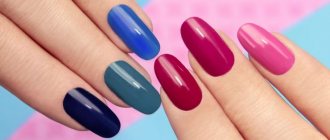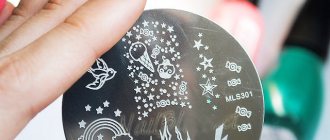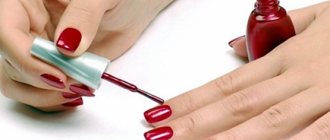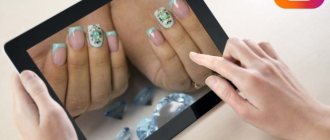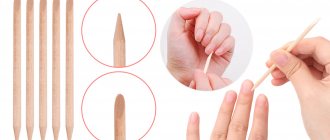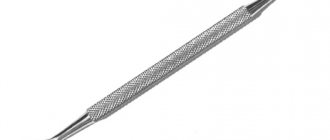Why are manicure kits sterilized and disinfected?
The rules for using manicure accessories are prescribed in SP 3.1.5.2826-10, SanPiN 2.1.2.2631-10. The requirements include 4 stages of processing: disinfection of used items, pre-sterilization cleaning (PSC), sterilization and storage of manicure instruments.
Sterilization of objects for manicure or pedicure is a measure to prevent the spread of infections. Pathogens are transmitted when a contaminated instrument comes into contact with a nail or with blood due to accidental damage to the skin.
According to the requirements of SanPiN, the master is obliged to disinfect his hands (his own and the client’s), workplace, and manicure tools.
Infection is possible through manicure tools:
- hepatitis C or B;
- herpes;
- HIV;
- nail and/or skin fungus;
- pyogenic microbes.
STAGE ONE – DISINFECTION OF INSTRUMENTS
Instruments should be disinfected in 2% Estilodez working solution. 1 liter is prepared taking into account the following proportions: 20 ml of water per 980 ml of water at room temperature.
When contacting disinfectant solutions, rubber gloves must be used.
Disinfection is carried out by completely immersing the instruments in the working solution for 5 minutes.
Methods for processing manicure tools
Sterilize with disinfectants and equipment with a physical and/or chemical disinfection mechanism.
Types of devices:
- for primary disinfection or PSO - ultrasonic baths/washes;
- for sterilization - autoclaves, dry heaters, boilers;
- for storage - bactericidal boxes, ultraviolet sterilizers.
Chemical treatment is done with disinfectants.
Boiling
The method is suitable for heat-resistant hand and hardware manicure items.
Rating of equipment for sterilization by boiling method:
- automatic electric boiler “KDEA 1-4”;
- disinfection electric boiler “E-40-1”;
- disinfection boiler “P-22-1” (for boiling on an electric stove).
Heat treatment is done after primary disinfection, PSO.
Sterilization algorithm:
- Clean items are placed in a boiler container with water.
- Waiting for it to boil.
- Boil for 20 minutes.
- The products are taken out with tongs and dried on sterile napkins.
It is advisable to boil in a 2% aqueous solution of “Sodium bicarbonate”. It increases the boiling point, improving the quality of sterilization.
Autoclave
Sterilization occurs under hot steam pressure with a temperature above +110 ºC. For manicure instruments, buy medical autoclaves of class B or S.
Cost of popular tabletop autoclaves:
- Prestige Medical Classic 2100, 9 l (Gehwol) - 63,500 rubles;
- TANZO C12, 12 l (Woson) - 100,000 rubles;
- STE-8, 8 l (IcanClave) - 103700.
The autoclave is used after primary disinfection, PSO. Disinfect objects that are resistant to hot steam.
Instructions for sterilizing manicure instruments:
- Water is poured into the autoclave, items are loaded, and sterilization indicator strips are laid out.
- They set the temperature and time and turn on the device.
- After processing, the products are transferred to a sterile place.
Manicure instruments are disinfected for 3–15 minutes. The exact duration of sterilization is indicated in the autoclave instructions.
Prestige Medical Classic
Dry heat cabinet
Manicure instruments in a dry heat are disinfected with air heated to a temperature of 180–200 ºC. Houses are treated with household sterilizers or in the oven.
For commercial purposes, dry heaters with Roszdravnadzor registration are used.
Rating of dry heaters for sterilization in the beauty industry:
- TAU Steril 2000 Automatic;
- "GP-20-3";
- "GP-10 MO".
Cabinets are used after primary disinfection, PSO. Manicure tools are placed in craft bags (for sterilization and subsequent storage), then placed in a heated dry heat.
TAU Steril 2000 Automatic
Glasperlene sterilizer
A glassperlene (aka ball) sterilizer disinfects at a temperature of +180–250 ºC in a container with small balls. Processes only the working surfaces of the tool.
Quartz beads must be replaced monthly, otherwise the quality of sterilization will decrease.
Disinfected in a Glasperlene sterilizer after disinfection, PSO, drying. The instrument is immersed in the heated balls for 20 seconds.
UV and ultrasound
Ultrasonic wash/bath/box - equipment for disinfection and PSO. Disinfects + cleanses using ultrasonic waves. Ultrasonic washers 1200 JP BYU, Eurosonic Micro, Dibea DADI DA-968 are popular.
Features of the use of ultrasonic washers:
- Disinfectant solution is poured into the container.
- Immerse used manicure tools.
- The sink is turned on.
- Afterwards, the product is washed under the tap, dried, and sterilized.
Manicure instruments are stored in ultraviolet boxes after sterilization without Kraft bags. The bactericidal environment in the device is maintained by UV lamps. The rating includes IRISK ZLP-C002, Planet Nails MiniGer, Germix two-chamber, FMX 898-8.
Kraft bags
The bags are used at the sterilization stage.
Products are available for use:
- in dry heat (heat-resistant);
- in autoclaves (do not get wet from steam);
- universal purpose.
The rating included craft packages “Steril” and “PSPV-Sterimag” from Medtest. Products with self-adhesive tape are suitable for autoclaves and dry heaters.
Application of kraft bag:
- Fill out the form on the front side.
- After PSO, the dry manicure instrument is loosely placed inside and sealed.
- The Kraft bag is placed in a dry heat/autoclave.
- To control sterilization, class 4 indicator strips are laid out in the chamber.
- Turn on the device.
After sterilization, the packages are not opened. The instrument is stored inside for 3–60 days, depending on the sealing method.
To watch the video:
Disinfection in solutions
Manicure products are disinfected with disinfectants containing surfactants, HOURS, triamine, guanidine, alcohol and/or an oxygen-containing substance.
Disinfectant solutions can be used step by step:
- primary disinfection (1st stage of disinfection);
- pre-sterilization cleaning;
- sterilization (if the material of the manicure product deteriorates due to high temperature or steam).
Disinfect with a ready-made product or a working solution prepared from a concentrate.
How to use the disinfectant:
- Liquid disinfectant is poured into the tray.
- Immediately after use, the manicure product is immersed in a disinfectant solution. The liquid should cover objects by 1–2 cm.
- After disinfection, the products are washed under the tap and dried. The exposure time is indicated in the disinfectant instructions.
After primary disinfection and PSO, sterilization is performed with equipment or a concentrated disinfectant solution.
See what mistakes it is better to avoid when processing:
STAGE THREE – STERILIZATION
We pack the instruments in special bags for sterilization. We indicate the contents, date, time of sterilization and expiration date of the sterilized instrument.
Next comes sterilization of the instrument. We must place the sterilization package in an autoclave at 134 degrees for 5 minutes (or another program in the case of gentle sterilization) or in a dry-heat oven at 180 degrees for 60 minutes. To monitor the operation of sterilizers, special external indicators are used; they are placed inside the chamber on a tray at five key points - in the corners and in the center.
Upon completion of sterilization, the sterilization packaging with sterile instruments should be placed in a desktop drawer or in a UV cabinet. The UV cabinet allows you to maintain the sterility of the instrument.
Next, fill out the quality control log of the sterilizer.
Remember that according to SanPiN, you are required to have three sets of tools in order to have time to disinfect the tools.
The best disinfectants for manicure tools
Use disinfectants against fungus, mold, microbes, and viruses. It is recommended to use disinfectants for PSO, sterilization and disinfection of medical devices.
The best disinfectants with a cleaning effect:
- “Mistral” concentrate - the instructions allow use in ultrasonic washes and manually, suitable for treating a manicurist’s workplace, instruments are disinfected for 30 minutes in a 4% disinfectant solution;
- con - suitable for treating instruments in any way, diluted for manicure products to a concentration of 8%, disinfected for 15 minutes.
"Mistral" or "Alaminol" can be used in everyday life and salons. Suitable for general cleaning, disinfecting clothes and shoes.
Rating of hand sanitizers and manicure tools:
- "Neosteril";
- "Estilodez".
The best means for sterilization, PSO and disinfection of manicure products are called “MultiDez”, “Optimax”. For quick disinfection + PSO, Dezecon is recommended.
How and how to sterilize manicure instruments: a review of disinfection liquids
The second very important stage is the processing of the tool itself. It is carried out in several stages: the first stage is disinfection. It allows you to remove viruses, fungi, and bacteria from metal tools. Disinfection is carried out with disinfectant liquids; they are sold either already prepared or sold in the form of concentrates that must be diluted with water, poured into a special container, and soaked in manicure tools. This treatment is carried out immediately after you have done a manicure on a person, your next client.
Kit
Tools should not be put aside, left or handled at the end of the day. It is unacceptable to do this, because cuticle residue, skin, and blood stick and dry to tweezers, tweezers or scissors, which are then quite difficult to remove during the washing process, which contributes to dulling of the instrument and increased frequency of sharpening.
Therefore, immediately after a hardware or classic manicure, the entire batch of tools that were used for this is soaked in the solution. Can be used as a standard disinfectant treatment or express treatment. For this, completely different liquids are used, and each master chooses the option that is most suitable. The fastest option is disinfection using Bacillol, AHD 2000 Express, Aerodesin.
Instructions:
- One of these substances is collected in a sprayer and treatment is carried out: spraying the cutting surface of scissors, wire cutters and other tools.
- After this, the cotton wool is moistened with the same solution and the blades of the pliers and scissors are wiped in order to remove any remaining skin and possible blood. For such disinfection, 30 or 60 seconds of liquid on the cutting blades of manicure instruments is sufficient.
- That is, disinfection is carried out almost instantly. The only drawback of such substances is their high price.
Soaking in solutions
Using disposable nail files
Rospotrebnadzor recommends using disposable manicure products.
Structure of reusable nail files and BAF:
- reduces the quality of sterilization;
- does not tolerate disinfectants and ultrasound;
- wears out quickly.
Disposable saw sets or individual tools are thrown away after use. There is therefore no risk of infection transmission and no costs for sterilization.
Manicurists advise using replaceable Smart abrasives for metal media. Discs or strips are discarded and the base is sterilized.
Why do you need to disinfect beauty salons?
The most common disease in beauty salons is fungus. A nail salon client can become infected with foot fungus - mycosis or get nail fungus - onychomycosis. This unpleasant skin disease is transmitted from a wet floor, an unsterile nail file, or a dirty nail bath.
Herpes is the second most common infection in beauty salons. You can earn it not only in a manicure chair, but also during cosmetic procedures.
The third place is occupied by staphylococcal infection. It attacks a person during various procedures that require trauma to the skin - for example, piercing, tattooing.
Hepatitis B and C took fourth place. Previously, it was believed that these viruses could enter the body during dental procedures and surgical interventions. For example, combing hair with a sharp comb, manicure, pedicure, eyebrow tattoo.
Home and salon treatment: differences
Disinfection of your own manicure instruments at home is carried out in 2 stages. Cleaning from contamination by washing and disinfection with antiseptics is mandatory. If desired, boiling, sterilizers and bactericidal boxes are used.
There are strict disinfection measures in the salons. Caused by the risk of contracting infections through manicure devices. All 4 stages of sterilization are performed in compliance with SanPiN and SP standards. It is also mandatory to treat the hands of the master and the client with an antiseptic, and disinfect the workplace.
Sterilization will protect against self-infection at home or transmission of the disease to the master/client in the salon through a manicure instrument. It is important to follow the rules of disinfection.
What do you use for sterilization? Comment and share the article on social networks with friends. Best wishes.
Types and processing technology
Clause 2.1.2.2631-10 SanPiN establishes requirements for sterilization of manicure devices. According to this document, the methods listed below are effective.
The table shows the comparative time of the procedure:
| Device | Time | Temperature |
| dry heat cabinet | from 60 min. | 180 °C |
| oven | 20 minutes. | 220 °C |
| autoclave | 20-30 min. | 134 °C |
| Glasperlen (ball sterilizer) | 20-40 sec. | 240-250 °C |
| ultrasonic sterilizer | 10 min. | Max. 40 °C |
| UV sterilizer | 40 min. (20 minutes on each side) | doesn't heat up |
| chemical solutions | up to 90 min. | 20-25 °C |
A ball sterilizer is considered the most effective, since when heated to the specified temperature, all known pathogenic microorganisms die.
Dry oven or dry oven
The sterilizing agent in this case is dry air, which has high penetrating properties for almost all types of materials. The cost of this equipment is from 3,000 rubles.
Application:
- Accessories treated by mechanical cleaning or chemical means must be placed in craft bags equipped with special indicators with a color signal.
- Place them in a dry-heat oven. If there are no craft bags, the devices are laid out using tongs.
- Start the sterilization process.
In addition to manicure hand tools, attachments for hardware manicure can also be subjected to this type of treatment.
Sterilizing manicure instruments in this way has the disadvantage of lengthy processing, which takes 40 minutes or more. up to 2 hours. That is, even at the stage of recruiting clients, a spare set must be available. Otherwise, the client will have to wait for the completion of sterilization, and due to lack of time, not everyone will agree to this.
Advantages of the device:
- the entire surface of the devices is processed;
- the dry-heat oven supports several temperature settings: from 160 to 260° C;
- dry and hot air in the cabinet eliminates the possibility of metal corrosion and glass surface erosion, thus extending the service life of the equipment.
Not all types of metal can be processed in a dry-heat oven, but only those made of cobalt alloys or Japanese steel. Parchment, paper, and some types of fabric are not suitable for these purposes.
In addition, it is prohibited to use rubber, plastic and other materials that cannot withstand the effects of temperature. Before starting processing, you must make sure that the items are heat-resistant.
Oven (oven)
A regular oven can also be used as an instrument sterilizer.
Application:
- Before carrying out the procedure, the devices must be cleaned and dried thoroughly.
- Place the tools in a preheated oven, the temperature should be 220 °C.
- After the allotted time has passed, they must be removed and left to cool completely.
Under no circumstances should accessories be immersed in cold water to cool them down. They may become dull or cracked. Only accessories made of metal are suitable for sterilization using this method.
Cardboard, plastic files, tongs with rubber or wooden handles are prohibited from being placed in the oven. After heat treatment, the metal should not be immersed in cold water.
Autoclave or steam sterilizer
Sterilization of manicure instruments occurs using hot steam, it is supplied under a pressure of 2 atmospheres. Such devices are more often used in salons than for home manicures.
Cost – from 5,000 rubles.
Application:
- The instrument must be placed in 1 layer, after having been cleaned and dried.
- To generate steam, distilled water must be poured into the autoclave.
- Start the sterilization program.
The main advantage of this method is the high efficiency of processing accessories.
Glasperlen or roll-on sterilizer
The device is a metal container in a plastic case with small quartz glass balls inside. After power supply, the heating elements of the sterilizer heat the balls to a temperature of 240 °C. Cost – from 700 rub.
Application:
- Plug in the device and pour the balls into it.
- Place previously washed and dried instruments.
- Start processing timer.
- Remove the accessories and wash them additionally in a disinfectant solution.
Before processing the devices, it is important to make sure that they are completely dry, otherwise rust will form on them from the remaining water. Every 3-6 months (depending on the frequency of use), the balls need to be changed, since their quality of heat transfer deteriorates, and the temperature during processing does not rise to 250 ° C.
Advantages of the device:
- compact and easy to use;
- quickly warms up to the desired temperature;
- has the shortest sterilization time;
- long service life;
- average price category;
- saves energy.
Flaws:
- Only the working part of the devices is subject to sterilization. If the handles are not made of metal, they remain untreated because quartz harms them;
- as a result of the fact that the working surface is lowered into quartz, which is an abrasive, the accessories become dull faster and require frequent sharpening;
- Only devices made of heat-resistant material can be processed;
- Quartz balls require regular replacement.
Ultrasound
The operation of the device is that ultrasonic waves are generated in a container filled with a solution. As a result, the pressure increases, forming a mass of bubbles that create the effect of cavitation. This effect removes bacteria, fungus, and dirt even from inaccessible places, so the treatment is of high quality.
Ultrasound can be used to sterilize not only metal, but also glass, plastic and ceramic devices. The cost of equipment is from 3,000 rubles.
Application:
- Immerse instruments for sterilization in the bath.
- Fill two-thirds of the volume of the device with a disinfectant solution. The temperature of the liquid should not be lower than 18 °C and not higher than 40 °C.
- Plug in the device and set the processing time on the timer.
- Start the sterilization process by pressing a button.
- After the set time has elapsed, the device automatically turns off and the accessories can be used.
Advantages of ultrasonic sterilizers:
- This type of sterilization is more effective than treatment in solutions. It allows you to get rid of most bacteria and dirt almost completely;
- suitable for disinfecting instruments made not only of metal, but also of glass, plastic, ceramics;
- as a result of ultrasonic sterilization, devices do not fail or become dull;
- even heavily soiled accessories are sterilized in just 10 minutes;
- unlike hot processing, there is no risk of burn injury;
- accessories can not only be disinfected, but also stored until reuse.
The disadvantage of ultrasonic sterilizer is that this type of treatment does not destroy all types of pathogens.
UV sterilizer
The device treats the surface of tools by irradiating with ultraviolet rays and is effective against rust. UV sterilizers come in several types - single- or double-chamber, with vertical and horizontal storage of accessories.
Cost – from 1,000 rubles.
Advantages of the sterilizer:
- UV lamps are easy to replace;
- You can process materials that cannot be sterilized by other methods, while ultraviolet radiation does not affect their performance.
Disadvantages of a UV sterilizer:
- long-term processing, which requires at least 40 minutes;
- the device disinfects and does not sterilize devices;
- Mostly used for storing accessories after processing.
Chemical treatment
Very often, special solutions are used to disinfect instruments. The work is performed under sterile conditions using disinfected utensils, rags and sponges for cleaning accessories. After this, the devices are stored in accordance with established standards.
After sterilization, accessories can be used no later than 3 days later, otherwise the treatment must be repeated. Sterilizing manicure tools using a chemical solution is not practical, which is why this method is rarely used. After processing is completed, the instruments are packaged in specially designed bags. They come in several types.
Kraft bags
Kraft bags are intended for one-time sterilization of manicure accessories with steam or air and their further storage. There is an indicator on the packaging indicating the quality of the treatment. Depending on the selected mode and processing method, the color of the indicator will change.
Kraft bags are made from special high-density paper; it prevents the penetration of moisture inside, the formation of condensation and ensures the sterile preservation of the instrument. Treated accessories can be stored in a sealed Kraft bag for 20-50 days, remaining sterile.
Before starting a manicure or pedicure, the packaging is printed in the presence of the client; he can verify the quality of the treatment using an indicator marker. After proper sterilization, it turns brown.
Sealed bags
This type of package is intended for ethylene oxide and steam treatment. The material is characterized by easy permeability of the sterilizing agent. When sealed, the bags remain impenetrable to all types of microorganisms, maintaining the sterilization regime of the accessories. No additional equipment is required for hermetically sealed sealing.
The sterility of the instrument is maintained for up to 20 days.
Thermally sealed paper bags
Heat-sealable paper bags are designed for air, steam and ethylene oxide sterilization. There are indicators on the outside of the package that allow you to distinguish processed instruments from unsterilized ones. The hermetically sealed package retains the sterilization regime for up to 30 days.
